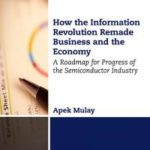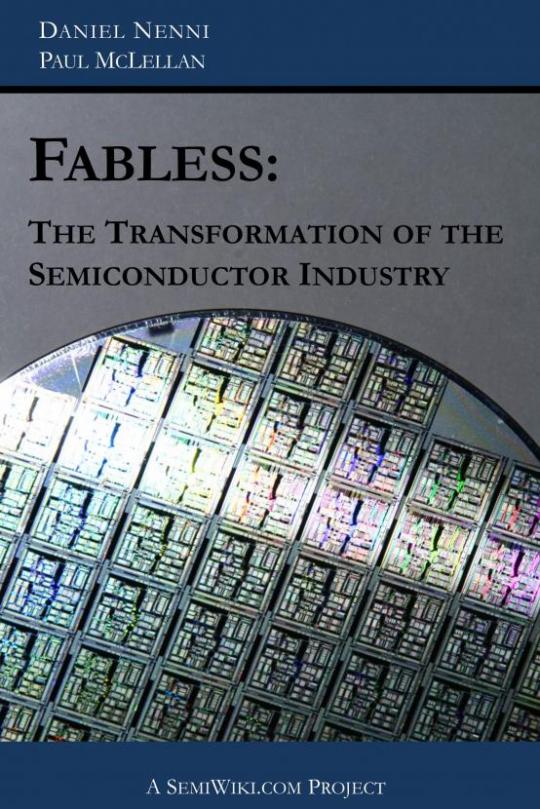Here is my review of Daniel Nenni and Paul Mclellan’s thought provoking book “Fabless- The Transformation of the Semiconductor Industry”. This review does not cover the last chapter “What’s next for the semiconductor Industry?”‚ I shall provide a critique on the opinions mentioned by semiconductor industry business leaders in a separate review.
Fabless semiconductor ecosystem leads to an active co-operation between foundries, EDA and IP vendors which accelerates innovation, according to semiconductor industry analysts Daniel Nenni and Paul Mclellan ( who would hence forth be represented only as Daniel Nenni ), in their thought provoking work, Fabless. According to Nenni, this co-operative collaboration ensures that design flows and critical IP are ready early in order to match demand of wafers with their supply. In this way, Nenni envisions that cooperation is the way forward for semiconductor industry and fabless industry model is the way to achieve the same.
Daniel also cites some examples of co-operation between different businesses and shows evidence of businesses prospering through co-operation. When both entities prosper then why would mergers and acquisitions be necessary in order to bring all employees under one platform? Nenni cites Synopsys as an example. As quoted from his work ‚In evolution of its vision of simulation known as ‚’smart verification’, Synopsys built discovery verification platform, a unified environment with all adjunct technologies developed enabling to combine system-level verification, HDL simulation, mixed signal simulation, test bench automation and functional coverage on a single platform. Nenni also shows how close collaboration with its customers has enabled Synopsys to formulate strategies and implement solutions to address latest semiconductor advances in creating a successful services offering.
Nenni also points out that Synopsys’s acquisition of Magma Design automation was based on the facts that Magma’s core EDA products were complimentary to Synopsys’s existing portfolio in IC implementation as well as analog design. This is something that semiconductor industry should take note of because there is an increasing consolidation that is happening today in this industry which is hurting innovation. Those Mergers and Acquisitions (M&As) which violate anti-trust laws and result in monopolies go against the principles of ‚ free market capitalism. When two companies have a complimentary portfolio, rather than pursuing path of M&As, pursuing co-operative collaboration works best in the interest of not only the companies and also their employees.
Nenni has also pointed out one particular industry where without any M&As, the whole company is doomed. He points out that for success in IP market; a company needs a broad portfolio and any company with just a handful of blocks was doomed. He mentions that IP business encouraged M&As and IPs made development of SOCs faster and cheaper.
Daniel also states ‚“The big EDA companies, to different degrees, were unable to develop completely new products and found it even harder to get into the channel with new products because switch to big bundled deals leave space for couple of licenses of immature product“. Through this statement, I believe Nenni has provided some evidence of loss of efficiency in extremely large size organizations that are formed as a result of M&As. Hence, In order to sustain innovations and increase efficiency in this great industry of ours, the size of company should not be too large and a robust growth of small businesses is critical.
Daniel also warns that companies that can’t adapt to changes in semiconductor manufacturing world are doomed. ‚ He mentions ‚”In all cases, Investors shy away from sticky technical problems for which modern chip design is a poster child“. For this reason, I believe it is very critical that semiconductor manufacturing and design to not solely depend on venture capitalists on the Wall Street but find an alternative to succeed if advanced semiconductor manufacturing has to make a come back to U.S.. Additionally, I believe that for growth of small businesses supporting new innovations in chip design would also need some major reforms in US capitalism to a free market economy.
Towards the end, Daniel provides an interesting success story about ARM. He mentions “ARM core was effectively unpowered and was running solely on leakage from IOs. This low power consumption was very valuable side effect of making ARM core cheap and turned out to be key to its success in emerging mobile electronics market“. Such unexpected beneficial side effects should act as a role model for global semiconductor industry research in finding ways to prolong the physical limits of Moore’s law for ICs. Hence, Semiconductor industry should continue in its investments in R&D of new products and processes in order to prolong the physical limits of Moore’s law.
Overall this book is a great read for semiconductor industry professionals. It describes the different business models in industry like fabless, IDMs, OEMs, etc. The authors‚ provide a brief summary of invention of modern Integrated Circuits (ICs) based industry. They explain the reader about Moore’s original predictions and how it has held true. The authors have done a great job in furnishing critical numbers in running today’s state-of-the-art fab like $50 per second and capacity to process 50,000 wafers per month. Nenni also presents to the reader a brief history of some great inventors of US semiconductor industry. He has demonstrated the fabulousness of fabless business model through transition in the number of‚ IDMs v/s pure play foundry over the years pointing out to the demise of IDM model. He gives evidence of the fact that the IDMs have been decreasing and foundries have increased in recent past.
This is a great book to understand all the intricacies in advancement of manufacturing technology over years. I found it really interesting to learn the origin of terms like ‘chip tape out’ which we use so frequently but really do not know where it originated from. Daniel explains how frontend and backend designs evolved over years. This book also furnishes the reader by classifying EDA system into five different phases. As a failure analyst, I have worked with different physical verification software like Dracula, Calibre, etc and it was good to be informed about some history of these software products.
I would certainly say, This book is a one stop shop for knowing a history of today’s fabless semiconductor industry, in particular, and global semiconductor industry in general. ‚ I personally believe “The Future of Global semiconductor Industry is Fabless for sustaining Moore’s law‚ and that is what also motivated me to write my upcoming book “Mass Capitalism : A Blueprint for Economic Revival” to be released nationwide on 17th October 2014.


Recent Comments